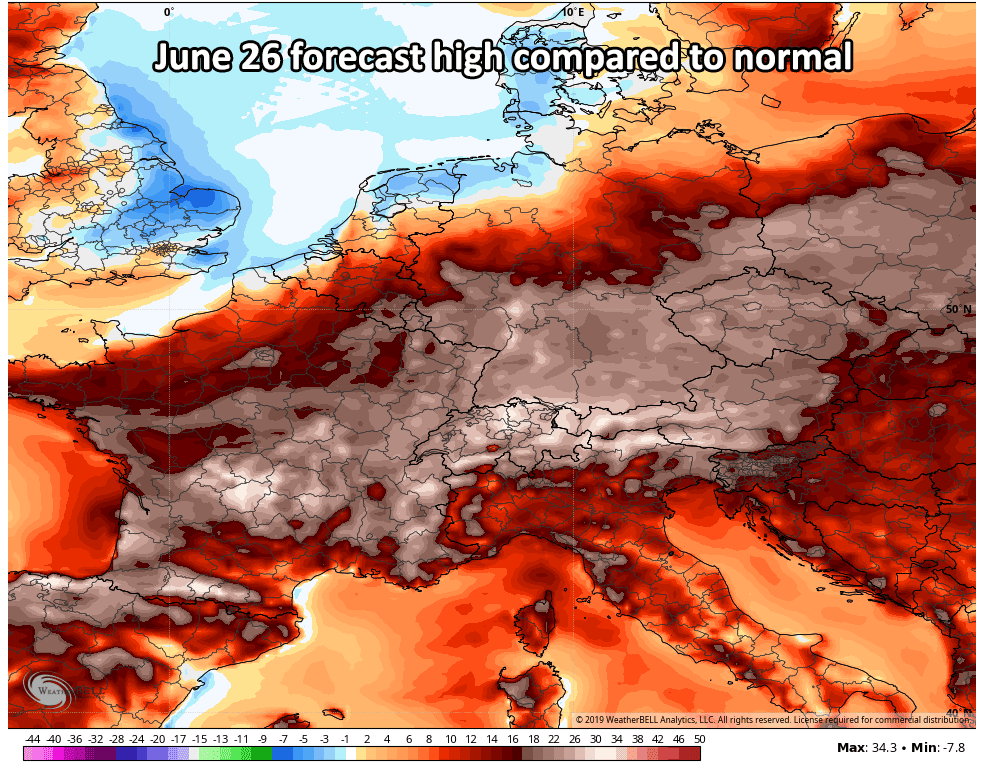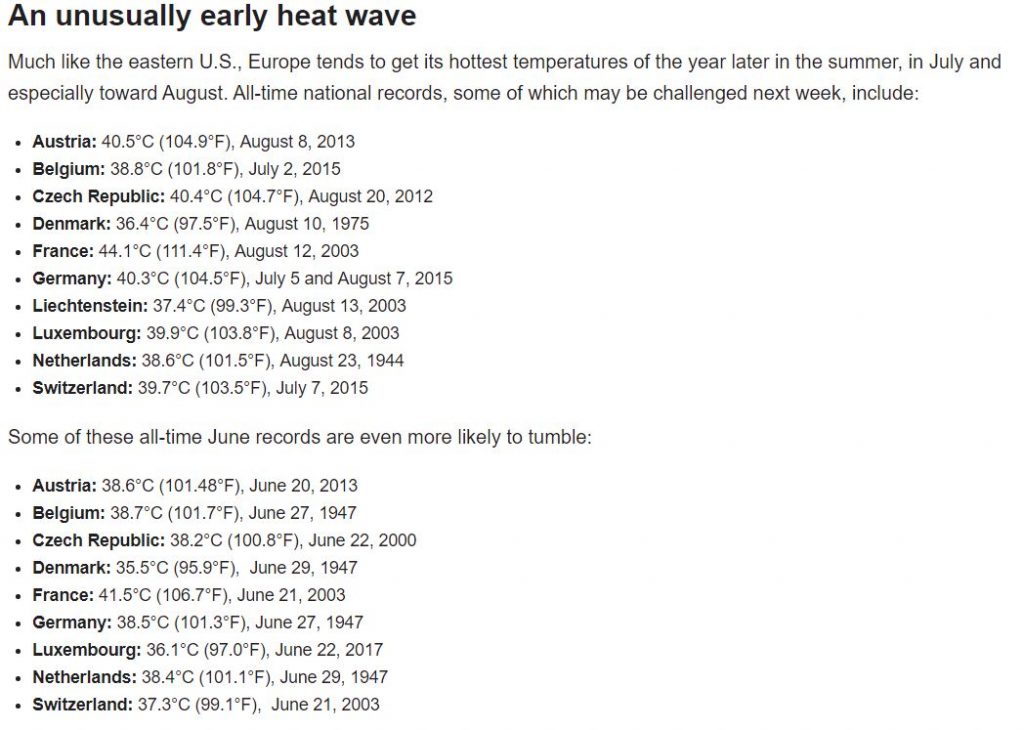An intense heat wave is set to bake Europe in coming days.
And it could be historic, potentially shattering records across a large portion of the continent.

After India, the European heatwave is expected to peak between Wednesday and Friday, when a swath from Spain to Poland is expected to see temperatures at least 20 to 30 °F (11 to 17 °C) above normal.
Actual temperatures should surge to at least 95 to 105 °F (35 to 40 °C) over a sprawling area. Some locations could be even hotter, especially within cities where a “heat island” effect from asphalt and concrete increases temperatures.
Mika Rantanen, a meteorologist in Finland, described computer model forecasts for the intensity of the heat “totally unheard of for June” in France.
The airmass (at 850 hPa) in France may be > 30°C this week.
— Mika Rantanen (@mikarantane) June 25, 2019
To get perspective how anomalous it is, here's ERA5 T850 maximum for any month and for June. Clearly an all-time record (at least for 41 years), and totally unheard of for June.#heatwave pic.twitter.com/YAhXExbUUO
Early summer heat waves can be especially lethal, as people have not yet had time to acclimatize to the higher temperatures. Older adults, the homeless and those without air conditioning are most susceptible to heat-related illnesses.
“Heat waves are silent killers,” tweeted Stefan Rahmstorf, a climate scientist at Potsdam University. “The 2003 European heat wave has caused about 70,000 fatalities. Last year’s hot summer in Germany has been estimated to have caused at least 1,000 excess deaths.”
Heat waves are silent killers. The 2003 European heat wave has caused about 70,000 fatalities, see https://t.co/48TOay2fXP Last year's hot summer in Germany has been estimated to have caused at least 1,000 excess deaths.
— Stefan Rahmstorf (@rahmstorf) June 24, 2019
The highest temperatures are likely to occur across western and central mainland Europe. Some of the hardest-hit in Spain and France are expected to see temperatures of at least 104 degrees (40 Celsius) for three straight days, Wednesday to Friday.
In a viral tweet, Silvia Laplana, a meteorologist in Spain, wrote “El infierno (Hell) is coming” The mercury is forecast to approach 105 degrees (40.6 Celsius) in Madrid on Friday, which would be its highest temperature ever recorded.
El infierno is coming. pic.twitter.com/j0iGEYF0ge
— Silvia Laplana (@slaplana_tve) June 24, 2019
In Paris, temperatures may approach 100 degrees Wednesday through Friday. The combination of heat and humidity will make for challenging conditions at the Women’s World Cup when the United States takes on France, although the game is set for 9 p.m. local time, when the worst conditions will have eased.
Paris, along with more than half of France, is under an orange alert, the second-highest level on the country’s heat scale. The scale was instituted after the 2003 summer heat wave, which was blamed for 15,000 deaths.
1. ☀️?️Hier, @MeteoFrance a placé Paris en alerte orange #canicule, celle-ci devrait courir jusqu’à dimanche prochain. Protégez-vous et vos proches de la chaleur ! Thread #CaniculeConseil ⬇️ pic.twitter.com/IHnbyVaeK4
— Agence Paris Climat (@AparisClimat) June 24, 2019
French meteorologist Gillaume Woznica said that the latest forecast leaves little doubt that France will set a new national heat record around 113 degrees (45 Celsius) on Friday, passing the old mark of 111 degrees (44.1 Celsius), set in 2003.
#Canicule : vers un nouveau record de #chaleur national ? Les dernières prévisions pour vendredi ne laissent guère de place au doute : des pointes à 44°C sont prévues entre le #Gard et le #Vaucluse. Météo-France prévoit 45°C (!!) sous abri à #Nîmes et #Carpentras… #chaleur @LCI pic.twitter.com/SH7qtGOPZK
— Guillaume Woznica (@GWoznica) June 25, 2019
Farther northeast, Berlin is predicted to flirt with the century mark Thursday, while Potsdam is forecast to break its all-time record by 3.6 degrees (2 Celsius). In Switzerland, Geneva is expected to be around 98.6 degrees (37 Celsius) Wednesday and Thursday.
Thread: some facts on heat waves, as Europe is waiting for a record-breaking #heatwave this week. https://t.co/yaYz0beLHw At our local Potsdam station operating since 1893, we're set to break the past June record by about 2 °C! @sciforfuture @GretaThunberg @parents4future
— Stefan Rahmstorf (@rahmstorf) June 24, 2019
Even Copenhagen on the main island of Denmark is set to head into the 80s.
In addition to France, a list of June national records that may be broken includes Austria (101.5), Germany (101.3) and Switzerland (99.1), as well as several others in the region. Some all-time records, mostly set in July or August, may also be threatened.

In the United Kingdom and Ireland, temperatures are not forecast to be as intense as in the south, but some spots should see readings into the 80s, which is considerably above normal for the time of year. Farther east in southern Sweden, as well as neighboring Denmark, some spots could approach 90 degrees.
Cause of heatwave
Part of the cause for the massive early-season heat wave is a pair of powerful high-pressure systems. One is near Greenland, and the other is over north-central Europe. As they become linked and flex over coming days, they’ll also act to block a low-pressure system to their south, which would draw cooler air over Europe.
Together, the zones of high pressure, combined with the cooler low-pressure zone offshore, will steer a “Spanish plume” over mainland Europe and the United Kingdom. The hot air plume, sourced from deserts in Spain and the Sahara, will spill over France, Britain and Germany.
Près de 26°c à 850 hpa (1500 mètres d'altitude) sur GFS au-dessus de Paris, jeudi prochain. Valeur véritablement insolite. Aucun doute à avoir quant à l'origine saharienne de la masse d'air. Rétro trajectoire du 22 au 27 juin. Source : https://t.co/RlpR3zCxNX (HYSPLIT) #canicule pic.twitter.com/u4ADigl92A
— Fred Le Fur (@CirrusSpissatus) June 23, 2019
The result can be a lot of falling records, and severe thunderstorms at times.

In some areas, the resulting heat will be an intensified version of what they’ve been dealing with already, while in others it will come as more of a shock.
June has so far been dominated by warmth in eastern and central Europe, with cooler-than-normal conditions over western parts of the continent.
Germany is seeing a top-five warmest June, with Potsdam, in the northeast part of the country, on its way to its warmest June on record. But farther west, this onslaught of heat represents something of a pattern change.
Thread: some facts on heat waves, as Europe is waiting for a record-breaking #heatwave this week. https://t.co/yaYz0beLHw At our local Potsdam station operating since 1893, we're set to break the past June record by about 2 °C! @sciforfuture @GretaThunberg @parents4future
— Stefan Rahmstorf (@rahmstorf) June 24, 2019
“So far this summer it’s often been cool and it’s often been raining,” the BBC noted.
This early heat wave is the latest in a number of historic episodes of heat in recent years. Just last summer, the continent saw relentless record temperatures coupled with unusually dry conditions. As a result, drought and wildfires were rampant.
“The hottest summers since 1500 AD in Europe were: 2018, 2010, 2003, 2016, 2002,” tweetted Rahmstorf.
The hottest summers since 1500 AD in Europe were: 2018, 2010, 2003, 2016, 2002. Each summer gets one vertical line, the histogram (grey steps) shows how frequent summers were in each temperature interval. Updated from Barriopedro et al in Science: https://t.co/qDuGzTOSjN pic.twitter.com/HEFi91w5sg
— Stefan Rahmstorf (@rahmstorf) June 24, 2019

The broader weather regime behind this heat wave has connections to the stagnant high-pressure zone responsible for the big Greenland melt event in mid-June. Both the Greenland melt and this heat wave are connected to a “blocking pattern” composed of big and lumbering high-pressure zones in the northern latitudes that can become stuck in place and lead to extreme weather.
Strong Rossby wave activity in the northern mid-lats since early June! Red=northward flow, blue southward flow. Watch the red blob linger over Europe, bringing in warm air. 7-day averages centered on the stated day, using forecast at the end. #heatwave pic.twitter.com/Cl6rvNTziC
— Stefan Rahmstorf (@rahmstorf) June 24, 2019
Such patterns may be becoming more common in a warming world.
The anomalous heatwave should peak later this week (Thursday, Friday), but warmer-than-normal conditions seem likely to persist for longer in much of western and central Europe. So keep cool and be patient.












Since when did they have a record of the temperatures in 1500AD?
Weather for #antichristobama
They’re raising the temperature in Europe to make the Muslim illegals feel at home.
I think you’re onto something here. Kill off all of the senior citizens in Europe and make room for the would-be Islamic usurpers.
Strange times indeed we are living in.
That’s funny. 🙂